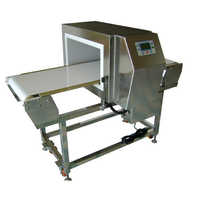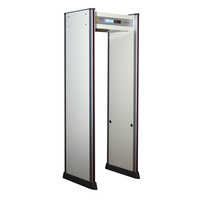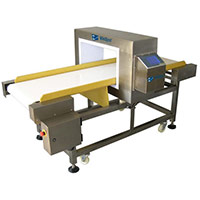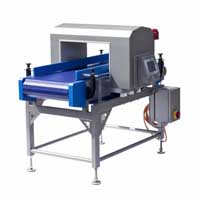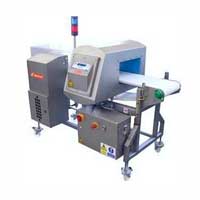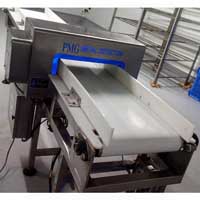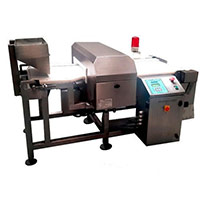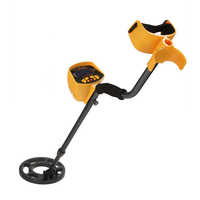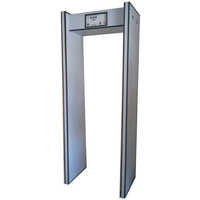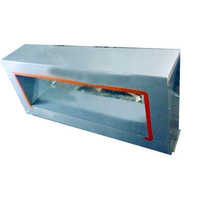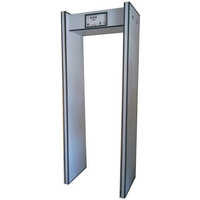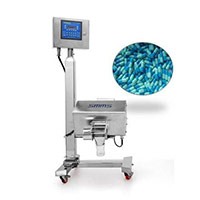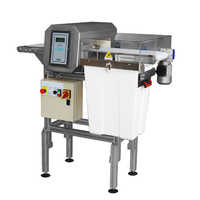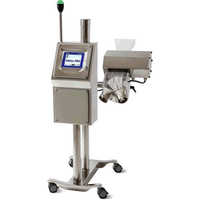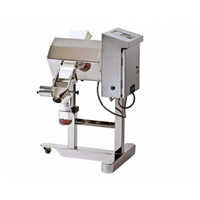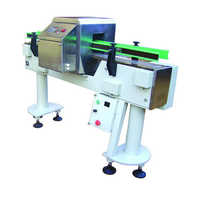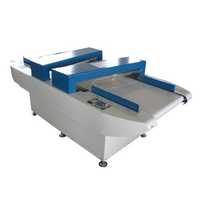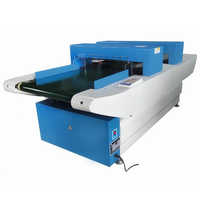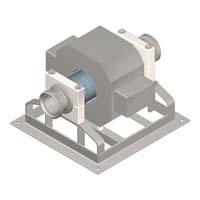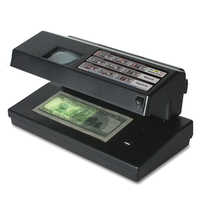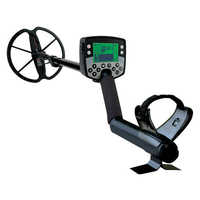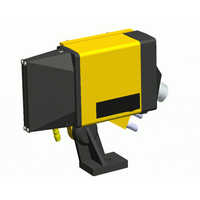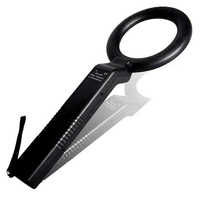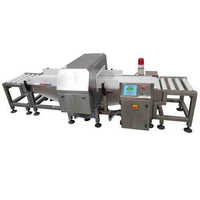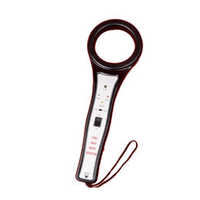Metal Detectors
(1745 products)
Top Metal Detectors Categories
Explore More Categories
Made in India
Automatic Food Metal Detector Application: Commercial & Industrial
Price: 265000 INR (Approx.)/Unit
MOQ - 1 Unit/Units
Power Supply - Electric
Product Type - Automatic Food Metal Detector
Color - Silver
3 Years
Business Type: Manufacturer | Supplier
MAGNA TRONIX
Black Vapor Trace Detector (Evd)
Price: 3000000 INR (Approx.)/Unit
MOQ - 1 Unit/Units
Dimension (L*W*H) - 300 X 180 X 90 Millimeter (mm)
Color - Black
Power Supply - DC 6V rechargeable battery
15 Years
Business Type: Manufacturer | Supplier
KAPRI CORP
Indian Inquiries Only
Made in India
Cashew Metal Detector
Price: 200000.00 INR (Approx.)/Unit
MOQ - 1 Unit/Units
11 Years
Business Type: Manufacturer | Supplier
LOCUS EXIM
Made in India
Door Frame Metal Detector
MOQ - 1 Piece/Pieces
4 Years
Business Type: Manufacturer | Supplier
SMARTECH SAFETY SOLUTIONS PVT. LTD.
Indian Inquiries Only
Metal Detector Machine Application: Commercial
MOQ - 10 Unit/Units
Usage - Commercial
Waterproof - No
Application - Commercial
2 Years
Business Type: Manufacturer | Distributor
WENZHOU TRUSTAR MACHINERY TECHNOLOGY CO., LTD.
Candy Metal Detector
Price Trend: 3000.00 - 4000.00 USD ($) (Approx.)/Set
MOQ - 1 Set/Sets
12 Years
Business Type: Manufacturer | Exporter
SHANGHAI FUDE MACHINERY MANUFACTURING CO., LTD.
Made in India
Stark Hand Held metal detector
Price: 38000 INR (Approx.)/, Piece
MOQ - 1 , Piece/Pieces
14 Years
Business Type: Manufacturer | Supplier
ANTRIKSH TECHNOSYS PVT. LTD.
Made in India
Grey Aggregate Conveyor Metal Detector
Price: 130000 INR (Approx.)/Piece
MOQ - 1 Piece/Pieces
Power Supply - 240 VAC
Product Type - Aggregate Conveyor Metal Detector
Material - Stainless Steel
2 Years
Business Type: Manufacturer | Distributor
A To Z Magnet Co.
Made in India
Led Remote Area Light Model Yk - Application: Na
MOQ - 1 Number
Input Power - 72w Watt (W)
Weight - 8380 Kg Approx Kilograms (kg)
Usage - na
14 Years
Business Type: Distributor | Supplier
KT AUTOMATION PRIVATE LIMITED
Indian Inquiries Only
Made in India
Metal Detector, Material: Iron
5 Years
Business Type: Manufacturer | Exporter
VIKASH INDUSTRIES
Multizone Door Frame
Price Trend: 60000.00 - 160000.00 INR (Approx.)/Piece
MOQ - 1 Piece/Pieces
Product Type - Multizone Door Frame
7 Years
Business Type: Manufacturer | Distributor
SAI SIDDHI ELECTRONICS
Metal Detector Machine For Food Industry
Usage - Detect metal in food items
Application - Food industry
Color - Silver
9 Years
Business Type: Manufacturer | Exporter
ZHAOQING FENGXIANG FOOD MACHINERY CO., LTD.
Conveyor Metal Detector Application: Commercial
Price: 65000 INR (Approx.)/Unit
MOQ - 10 Unit/Units
Waterproof - Yes
Product Type - Conveyor Metal Detector
Usage - Commercial
2 Years
Business Type: Manufacturer | Supplier
SHRI NATH ENGINEERS
Made in India
Metal Detectors Waterproof: No
Price Trend: 280000.00 - 380000.00 INR (Approx.)/Unit
MOQ - 1 Unit/Units
Usage - It is use for detecting foreign objects.
Waterproof - No
Material - Steel
17 Years
Business Type: Manufacturer | Exporter
UNIQUE EQUIPMENTS
Made in India
Hand Held Metal Detectors
18 Years
Business Type: Exporter
GLOBAL TELE COMMUNICATIONS
Made in India
Door Frame Metal Detectors Application: At Security Check Points
MOQ - 10 Piece/Pieces
Sensitivity - high
Product Type - Door Frame Metal Detectors
Color - White
Business Type: Manufacturer | Supplier
T M S Services and Wireless Solutions
Made in India
Folding Arm Boom Barrier Application: Industrial
Price: 69999 INR (Approx.)/Piece
MOQ - 1 Piece/Pieces
Application - Industrial
Color - Black & Yellow
Material - Mild Steel
4 Years
Business Type: Manufacturer | Exporter
LIVFUTURE AUTOMATION & SECURITY PVT LTD.
Indian Inquiries Only
Made in India
Tablet Metal Detector Application: Inspection System For Pharma Industry
Price: 1500000 INR (Approx.)/Number
MOQ - 1 Number
Alarm - Yes
Waterproof - Yes
Product Type - Inspection System for tablets and capsules
7 Years
Business Type: Manufacturer
JAY INSTRUMENTS & SYSTEMS PRIVATE LIMITED
Made in India
Silver Pharma Metal Detector
Price Trend: 260000.00 - 320000.00 INR (Approx.)/Unit
MOQ - 1 Unit/Units
Material - SS
Color - Silver
Warranty - Yes
4 Years
Business Type: Manufacturer | Exporter
UNIQUE ENGINEERING
Made in India
Digital Wall Scanner
10 Years
Business Type: Distributor | Exporter
APAN ENTERPRISE
Made in India
Amit Metal Detectors Android Version: N/A
Business Type: Supplier | Service Provider
AMIT SAFETY ENTERPRISES
Indian Inquiries Only
Made in India
Door Frame Metal Detector Application: N/A
Price: 85000 INR (Approx.)/Piece
MOQ - 1 Piece/Pieces
Technology - Door frame metal detector
Special Features - airports, hotels, malls, industries
Remote Control - No
8 Years
Business Type: Manufacturer | Exporter
GLOBAL STAR
Indian Inquiries Only
Made in India
Silver Digital Metal Detector
Price: 350000 INR (Approx.)/Unit
MOQ - 1 Unit/Units
Material - SS
Warranty - Yes
Waterproof - No
4 Years
Business Type: Manufacturer | Exporter
TARGET INNOVATIONS
Metal detector
Price: 150000.00 INR (Approx.)/Unit
MOQ - 1 Unit/Units
7 Years
Business Type: Manufacturer | Distributor
JD MAGNETIC IMPEX
Made in India
Walk Through Metal Detector
10 Years
Response Rate: 70.67%
Business Type: Manufacturer | Distributor
TAHERI ENTERPRISES
Made in India
Hand Held Metal Detectors Waterproof: No
Price Trend: 1200.00 - 3500.00 INR (Approx.)/Piece
MOQ - 10 Piece/Pieces
Waterproof - No
Material - Metal
Input Power - <35 Kilowatt (kW)
10 Years
Business Type: Distributor | Trading Company
ANUPAM UDYOG
Indian Inquiries Only
Made in India
Hand Held Metal Detector Scorpion 700140 Application: Access Control
Price: 3900 INR (Approx.)/Piece
MOQ - 1 Piece/Pieces
Weight - 400 Grams (g)
Dimension (L*W*H) - 295 x 68 mm x 28 mm Millimeter (mm)
Application - Access Control
8 Years
Business Type: Manufacturer | Distributor
KAMPUS CARE
Made in India
Silver Door Frame Metal Detector With Thermal Camera
Price: 220500 INR (Approx.)/Unit
MOQ - 1 Unit/Units
Application - Mall, Metro station, Office, etc.
Product Type - Door Frame Metal Detector
Color - Silver
2 Years
Business Type: Trading Company
SRRB INFRA PRIVATE LIMITED
Indian Inquiries Only
Metal Detectors Manufacturers | Suppliers in India
| Company Name | Location | Member Since |
|---|---|---|
| Global Tele Communications | Hyderabad, India | 18 Years |
| Unique Equipments | Chicalim, India | 17 Years |
| Kapri Corp | Mumbai, India | 15 Years |
| Antriksh Technosys Pvt. Ltd. | New Delhi, India | 14 Years |
| Kt Automation Private Limited | Vadodara, India | 14 Years |
| Shanghai Fude Machinery Manufacturing Co., Ltd. | Shanghai, China | 12 Years |
| Locus Exim | Pune, India | 11 Years |
| Apan Enterprise | Vadodara, India | 10 Years |
| Taheri Enterprises | Mumbai, India | 10 Years |
| Anupam Udyog | Kolkata, India | 10 Years |
What Is A Metal Detector?
A metal detector is an electrical device that can detect the presence of metal items, such as those left on the ground after a sweep or those installed in an archway at an airport terminal to search for hidden weapons, bombs, etc. Metal detectors can locate metal objects by sending an electromagnetic field into the ground from the search coil. Any metal items (targets) within the field's range will be energized, causing them to emit their own electromagnetic field.
In the 1920s, a new era in metal detector development began. When properly implemented, Gerhard Fischer's radio direction-finding technology would make precise navigation possible. Fischer discovered certain oddities in the system in regions where the landscape held ore-bearing rocks, even though the system performed quite well overall.
How Metal Detector Works
1. Input/Output Module
Electronics for the detector can be found in its control box. Here, it produces the outbound signal and transforms the incoming one into the desired response.
2. Electromagnetic Field Transmission
When a target is sent an electromagnetic field, it becomes active and may be picked up by the receiver.
3. Unwanted Target
In most cases, ferrous (attracted to a magnet) objects like nails and non-ferrous objects like bottle caps make up unwanted targets. Rejecting undesirable targets prevents the metal detector from producing a target response for such targets if this option is activated.
4. Analyzed by a Searching Coil
The electromagnetic field is sent into the ground through the detector's search coil, which then picks up the target's reflected field.
5. Target
Any item that can be located with a metal detector is considered a target. Treasure is an acceptable target in this scenario and hence it has been discovered.
6. Target Response
It is common for metal detectors to emit a beep or other audible response whenever they locate a valid target. Target information, such as an ID number or a 2D representation, may be shown on the screen of several detectors.
7. Receive Electromagnetic Field
The search coil picks up the electromagnetic field emitted by the energized objects.
Types Of Metal Detector
1. 3D Imaging Metal Detectors
Detectors using 3D imaging technology scan the ground with specialized probes. After the scanning is complete, the data is typically shown as a three-dimensional graphic on a computer screen or Tablet, detailing the topography of the search region and the locations of any hidden targets.
However, the correct findings for the treasure seeker and professional searcher are guaranteed by the high precision and coverage of a large field of scan and many characteristics of these devices.
2. Electromagnetic Metal Detectors
Very low frequency (VLF) and pulse induction technology (PI) are the two primary search technologies used in electromagnetic metal detectors. The metal detector price in india starts from 1,799 to 3,30, 000 INR. Both rely on a search coil to detect the presence of various metals, including gold, within the search area underneath the coil and then alert the user with an audible tone that varies in pitch depending on the type of metal detected.
Despite their shallow depth range (maximum: 3 meters) and low cost, they are the most often used devices worldwide.
3. Multi-frequency Metal Detectors
VLF metal detectors are restricted in their use since they can only function on a particular frequency. Multi-frequency detectors were developed as a workaround for this defect in the original design. What I’m talking about here is the capability of employing several different frequencies at once. Calibrating the frequencies allows for the simultaneous detection of objects both shallow and deep.
A multi-frequency system is not the same as a frequency-selectable system. Metal detectors with a selectable frequency range are frequently misrepresented as being capable of operating on several frequencies. Although they support a wide range of frequencies, you can only utilize one at a time.
4. Very low frequency (VLF) Metal Detectors
In the hobbyist market, this is the most prevalent metal-detecting method. The transmitter and receiver in this design each include two coils. The electrical currents are sent into the earth by the transmitter. Objects made of metal within this range will generate their magnetic field. As soon as the receiver coil picks up this kind of reaction, it will evaluate the signal and relay the results to the command center. If your metal detector has a visible display, you'll see the target ID there; otherwise, you'll hear a tone, beep, or sequence of beeps.
5. Pulse Induction (PI) Metal Detectors
The same holds for security reasons if there is a personal one. To check for hidden weapons, security personnel frequently employ the pulse induction metal detector. If you've been stopped at a roadside checkpoint and a security, the agent is strolling around your vehicle with a metal detector, they are most likely utilizing a pulse induction model.
PI uses a single coil or several identical coils to achieve the same effect as VLF's pair. The metal's response serves as a "pulse" in this echolocation system. Particularly well-suited for use in gold panning and beach hunting. Because of the highly mineralized soils typically encountered while looking for gold or in and near seawater, these are two of the most challenging forms of metal detecting operations.
Applications Of Metal Detector
1. Pharmaceutical Sector
Metal detectors play an important role in the pharmaceutical sector, aiding in a wide range of procedures. Similar methods are employed to ensure that pharmaceutical items are metal-free by detecting their presence. It's in everyone's best interest to keep the product safe and of high quality.
However, these medications and treatments undergo processing to generate a stable antioxidant while being included in the food, tableware, and pharmaceutical items. Multiple compounds containing double and triple bonds that need hydrogenation are produced during the manufacturing of medicinal products.
Metal toxins are generated in a variety of byproducts during the hydrogenation process. The result of a synthesis involving the separation of compounds using various metal catalysts is a product of separation.
2. The Construction Trades
Steel reinforcing bars embedded in concrete may be located with a metal detector, as can metal pipes and wires concealed in the floors and walls. When it comes time to replace the plumbing or wiring in a home or business, this helps prevent further damage.
3. The Search for Land Mines
Small amounts of metal (0.5 grams) are detected by the land mine detector. For this reason, modern militaries rely on land mine detectors to determine the presence of land mines. Since World War I, the military has utilized metal detectors to locate hidden land mines.
4. Airport and Building Security
To detect firearms, knives, and other weapons, metal detectors are installed at airports and other public places.
5. Civil Engineering
Rebar (reinforcing steel rod) is often hidden within the concrete; hence metal detectors are employed in civil engineering to find it. The technology used in rebar detectors is simpler. Metal items are only detectable at depth.
Changing the electric flux is the primary mechanism at work. The current-carrying balanced bridge circuitry is housed in the metal detector. The electromagnetic flux fluctuates as the sensor gets closer to the metal, throwing off the circuit's equilibrium. This aids metal detection.
The metal detector's readings should be exact and reliable at all times. Their cutoff is determined by the requirements of the task at hand. Once the threshold is crossed, they begin their operations. Therefore, manufacturers must provide correct thresholds by the need.
FAQs: Metal Detector
Q: What is the best metal detector that you can buy?
Ans: Here is the best metal detector you can buy online:
- Minelab Go-Find 22: A best budget metal detector for beginners and kids.
- Garrett Ace Apex HP: Best all-round, high-end detector.
- Minelab Go-Find 66: Best intermediate metal detector.
- Garrett Ace 400i: Best high-end mid-priced metal detector.
Q: How deep will a metal detector detect?
Ans: Metal detectors typically have a depth range of 10–20 cm (4–8 inches). A standard metal detector's depth of field is 30–45 centimeters (12–18 inches) when circumstances are optimal. Specialized detectors can reach depths of up to 65 feet (20 m). Finding what you're looking for is easier if you have as much information as possible about it. The depth to which a metal detector can penetrate a target depends on factors like the target's metallic nature, size, form, and direction.
Q: Can a metal detector detect diamonds?
Ans: This brings up a crucial point: precious stones, diamonds, and pearls will go undetected by a metal detector. Prospectors utilize metal detectors because they can help them locate indicator minerals. Indicator trails lead prospectors back to potential gold or diamond-bearing volcanic pipe deposits.
Q: What I need to know before buying a metal detector?
Ans: Consider the following features before buying a metal detector:
- Depth of Detection
- Coil Size
- Pinpointer
- Weight
- Purpose
- Cost
Related Categories
Access Control Cards
Alarm
Bulletproof
Burglarproof
Electronic Locks
Electronic Safe
Fire Vehicle & Accessories
Fire-fighting & Fire Protection Equipment
GPS Devices
Helmets
Lifesaving
Locks
Metal Detectors
Personal Safety Equipment
Riot Control
Roadway Safety
Safe
Security Equipment
Security Fencing
Security Product Agents
Security Project
Surveillance Equipment
Traffic Signal Equipment
Warning Tapes
